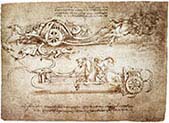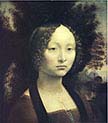Leonardo da Vinci
1452-1519 Italy/Early Renaissance.
Click an Image to Enlarge
The
Last Super

The Baptism
of Christ

The
Annunciation

Madonna
Benois

Madonna
Litta

Madonna with
the Carnation

Unknown
Woman

John the
Baptist

Vitruvian
Man

Automobile

Assault
Chariot

Antique
Warrior

Study of Cats
and Dragan

Battle of
Anghiari Detail

Hemisected
man
and Woman

Flying
Machine

A Parabolic
Compass

Design for a
Large Crossbow

Studies
of Embryos

Five
Heads

the virgin and child
with saint anne

Virgin
and Child

A
Young Man

Sala
Delle Asse

The Virgin
of the Rocks

Ginevra
de Benci

Lady with
Ermine

Ginevra
de Benci

Saint John
the Baptist

Leda

Mona Lisa
